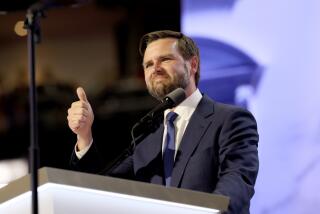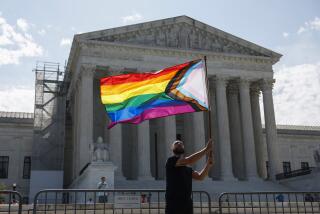Will Institution of Marriage Continue? It’s Debatable
In the era of “Temptation Island” and “Sex and the City,” the prime-time Valentine’s Day offering on PBS seems almost anachronistic: an earnest documentary examining the status of marriage in the United States.
But for a loose alliance called the Marriage Movement, the program represents a victory of sorts.
Formed two years ago to bridge the left-right divide over family issues, the coalition of scholars, clergy, family counselors and others tries to promote strong marriages and reduce a U.S. divorce rate estimated at 40%. Step one is getting people to take marriage seriously.
“We want to get a good conversation going with the broader society,” said Don Browning, a University of Chicago Divinity School professor who helped found the Marriage Movement and create the PBS documentary “Marriage--Just a Piece of Paper?”
“Marriage developed in the West as a public institution, nourished by religious and cultural traditions,” he said. “We may be in the process of dismantling it, and before we do, we ought to think about it.”
But what, exactly, should we think? Although polls show most Americans aspire to a lasting, loving marriage, the topic is often divisive, and pivotal questions lack simple answers.
Have no-fault laws made divorce too easy? If there is a marriage crisis, will it correct itself, or are new policies needed? Can government promote marriage without discriminating against unmarrieds?
Several state legislatures recently have ventured into marriage policy, testing initiatives that might reduce divorce without triggering an ideological backlash.
Florida requires marriage education courses in high school. Louisiana, Arkansas and Arizona approved “covenant marriages” in which couples voluntarily limit their ability to divorce. Arizona provides state funds to help couples attend privately run marriage-skills workshops.
Staffan and Jane Berg signed up for one. Both 47, they have been married for nearly 20 years and run a flower shop in Tempe, Ariz. They attended three two-hour sessions on marital communication skills offered by FranklinCovey, a company better-known for workplace training programs.
“We’ve always been keen on tuning up our marriage,” said Staffan Berg. “I don’t think anybody can do something for so long without having some continuing education. It helps to hear about the experiences of others.”
Berg, a native of Sweden, says the flower business gives him insight into American romance.
“People are keen on sending a lot of flowers before they get married, and then after marriage they don’t send anything,” he said. “It’s no wonder marriages don’t last if people don’t make the same effort afterward as before.”
Several of the Arizona workshops are run by the Lutheran Social Ministry, which made a pitch at a recent bridal show.
“When people are looking for their wedding dress and their caterer, it’s easy to let relationship work take the back burner,” said the ministry’s program director, Traci Gruenberger. “It’s amazing that people come in [to the workshops] and haven’t talked about finances or whether they want to have children.”
Perhaps the most ambitious state program is in Oklahoma, where Gov. Frank Keating wants to use millions of welfare dollars in a multi-pronged effort to reduce the high divorce rate. David Fournier, a professor of family science at Oklahoma State University, has doubts about the initiative’s staying power.
“We can have speakers come in and be eloquent and fire people up, but when they leave, what’s left?” Fournier asked. “Where are those resources going to come from?”
The recent torrent of federal census data has provided ammunition for almost every viewpoint in the marriage debate.
Those who celebrate a diversity of family structures welcomed the increases in all major types of nontraditional households--single parents, nonmarried heterosexual couples, same-sex couples.
For many in this pro-diversity camp, the nuclear family archetype that dominated post-World War II pop culture was never as wonderful, or entrenched, as it seemed.
“Some people have this false nostalgia for something in the ‘50s that just wasn’t there,” said Andrea Engber of Midland, N.C., founder of the National Organization of Single Mothers.
Those who believe American society should promote the Mom-Dad-and-kids nuclear family above other forms also were encouraged--cautiously. They say the trends that most alarmed them have subsided, and hope the nation is ready to reembrace the ideals of traditional marriage.
“It’s too early to say we’ve turned the corner, but there is at least the possibility,” said David Blankenhorn, president of the Institute of American Values. “For about 30 years, we had a continuing deterioration of the married-couple, two-parent home, but that deterioration seems to have stopped.”
Compared with 40 years ago, some of the recent census figures on marriage are striking.
Married couples with children under 18--the classic nuclear family--now make up 23.5% of all households, compared with 45% in 1960. The percentage of single-person households nearly doubled to 25.5% during that span; unmarried-couple households jumped from 0.8% to 5%.
But Blankenhorn--whose private, nonpartisan institute promotes “the renewal of marriage and family life”--is heartened by several trends: fewer teen pregnancies, a higher percentage of black children living in two-parent homes, a modest drop in the divorce rate that exploded in the 1970s.
“For a long time, many people said there was nothing to be done about the weakening of the family, that we can’t roll back the clock to Ozzie and Harriet,” he said. “That thesis has been empirically disproved.”
Blankenhorn and others in the Marriage Movement engage in a running debate with groups like the New York-based Council on Contemporary Families, which encourages evenhanded support for all family forms.
Stephanie Coontz, who chairs the council and teaches history at Evergreen State College in Olympia, Wash., said the nuclear family--even by other names--wasn’t a preoccupation during most of American history.
“You weren’t supposed to spend all your time with your children and spouse,” she said. “This was a new value in the 1950s. It became publicized by the sitcoms, it was subsidized by the government through the G.I. Bill, it took over for about 20 years, then it started to fade and everybody said the traditional family is dying.”
Coontz believes the American family is in a period of irreversible transition, and hopes the result is a national consensus that both old and new family structures can succeed.
“It’s one thing to promote good marriages,” she said. “But do you want to promote marginal marriages?”
The scriptwriter for “Marriage--Just a Piece of Paper?”--Barbara Dafoe Whitehead--said marriage has had a roller-coaster history and may now be on the upswing.
“There was a time in the ‘70s when many people did think marriage was bankrupt, but you don’t hear that as much now,” she said. “Generation Xers are frightened by the possibility of divorce--they’ve seen too much of it, and they want to make marriage work.”
Whitehead, co-director of the National Marriage Project at Rutgers University, favors modest, noncoercive measures to strengthen marriage.
The institution will stay with us, she said, partly because it has an enduring mystery about it.
“We don’t really know very much about why people choose to marry, or what the ingredients are in marriages that survive all the usual bumps on the road,” she said. “It can’t be reduced to a bundle of skills.”
*
On the Net:
TV documentary: https://www.marriagetv.uchicago.edu
Marriage Movement: https://www.marriagemovement.org
Council on Contemporary Families: https://www.contemporaryfamilies.org
More to Read
Sign up for Essential California
The most important California stories and recommendations in your inbox every morning.
You may occasionally receive promotional content from the Los Angeles Times.










